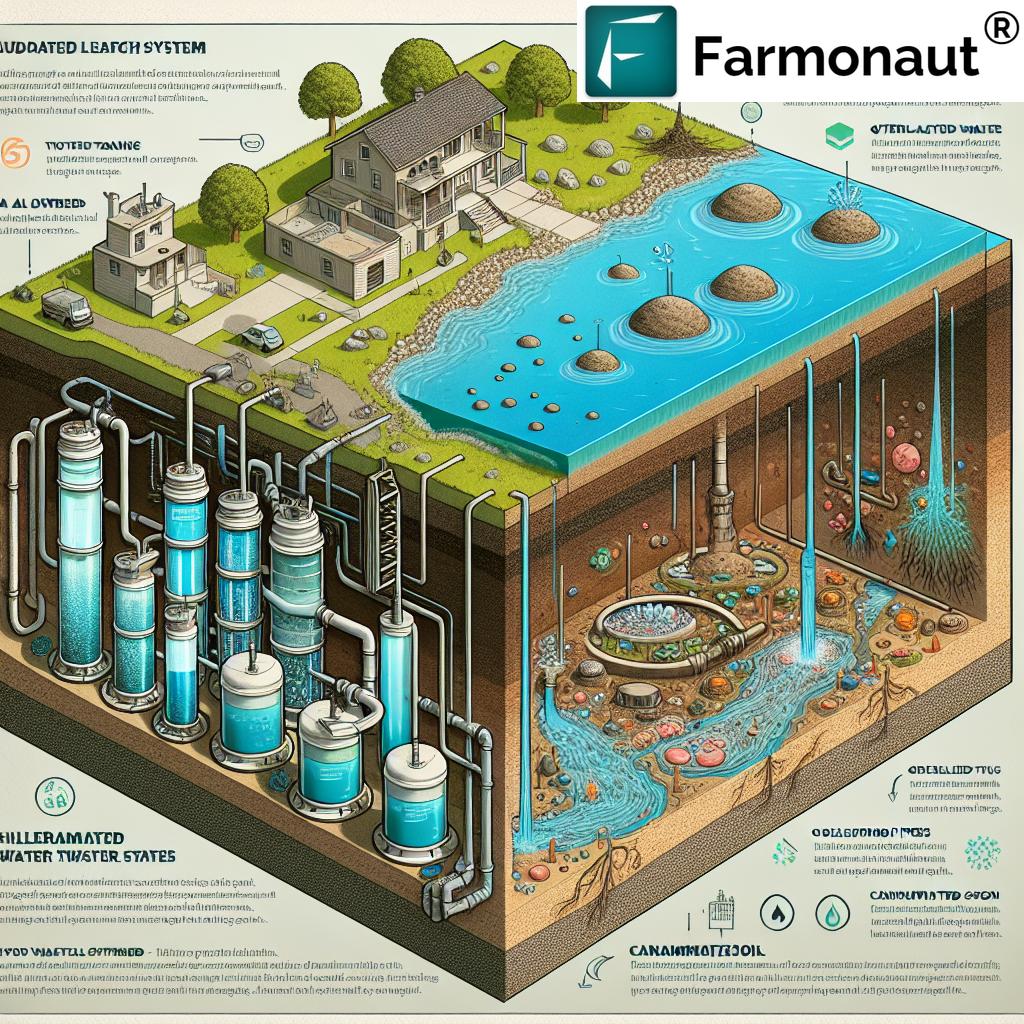Ohio’s Water Quality Crisis: How Failing Septic Systems Impact the Hocking River and H2Ohio’s Solution
“Over 50% of Athens County’s Hocking River is unsafe for recreation due to E. coli contamination from failing septic systems.”
As we delve into the complex world of water quality in Ohio, particularly in Athens County, we find ourselves facing a critical environmental and public health challenge. The Hocking River, once a symbol of natural beauty and recreation, now stands as a testament to the urgent need for improved wastewater treatment and septic system management. In this comprehensive exploration, we’ll uncover the root causes of this crisis, examine its far-reaching impacts, and discuss the innovative solutions being implemented to restore the health of our precious waterways.
Understanding the Scope of the Problem
The water quality crisis in Ohio, particularly in Athens County, is a multifaceted issue with deep-rooted causes. At the heart of this environmental predicament lies a startling statistic: only 10 out of numerous testing sites along the Hocking River meet the recreational water quality standards set by the Ohio Environmental Protection Agency (EPA). This alarming revelation underscores the severity of the situation and the urgent need for action.
E. coli contamination, a primary concern in this crisis, poses significant health risks to the community. The Environmental Protection Agency warns that exposure to E. coli can lead to serious health issues, including severe diarrhea and vomiting. As stewards of our environment and public health, we must address the sources of this contamination to protect our communities and natural resources.

The Role of Agricultural Runoff
While failing septic systems are a significant contributor to water pollution, we cannot overlook the impact of agricultural runoff, particularly from livestock waste. Recent testing in Margaret Creek, a tributary of the Hocking River, revealed high levels of contamination directly linked to cattle access to the waterway. This highlights the need for a comprehensive approach to water quality management that addresses both urban and rural sources of pollution.
However, the regulatory landscape complicates efforts to address agricultural runoff. The Ohio EPA lacks direct regulatory authority over farms, necessitating collaboration with the Ohio Department of Agriculture to implement effective pollution control measures. This interagency cooperation is crucial for developing holistic solutions that balance environmental protection with the needs of the agricultural community.
The Evolution of Wastewater Treatment
Over the years, advancements in wastewater treatment technology have played a pivotal role in improving water quality. Ohio EPA Director Anne Vogel provides historical context, noting that in the past, untreated sewage flowing directly into waterways was a common occurrence. Today, while modern wastewater treatment plants have significantly reduced this type of pollution, we face a new challenge: the failure of private septic systems.
A 2013 report from the Ohio Department of Health revealed a troubling statistic: approximately 31% of home sewer systems in the state are malfunctioning. This translates to an estimated daily discharge of 120 million gallons of inadequately treated wastewater into our environment. The scale of this problem underscores the critical need for investment in septic system infrastructure and maintenance.
Regulatory Challenges and Local Oversight
The oversight of septic systems in Ohio falls under the jurisdiction of local health departments rather than the Ohio EPA. This decentralized approach to regulation presents both challenges and opportunities. While it allows for more localized management tailored to specific community needs, it can also lead to inconsistencies in enforcement and standards across different counties.
In Athens County, the local health department has taken proactive steps to address the issue of failing septic systems. Patrick McGarry, Environmental Health Director for the Athens City-County Health Department, has implemented new requirements for septic system maintenance and inspection. All newly installed systems must now undergo a five-year maintenance inspection, a measure aimed at preventing future failures and protecting water quality.
The H2Ohio Program: A Beacon of Hope
“H2Ohio program allocates millions to address water quality issues, targeting both agricultural runoff and outdated septic infrastructure.”
In response to the growing water quality crisis, Governor Mike DeWine introduced the H2Ohio program, a comprehensive initiative designed to address a range of water quality issues across the state. This innovative program focuses on critical areas such as reducing harmful algal blooms, improving wastewater infrastructure, and replacing failing septic systems.
Since its inception, H2Ohio has made significant strides in Athens County, providing over $500,000 in funding for various projects aimed at improving sewer systems. This investment represents a crucial step towards modernizing the county’s wastewater treatment infrastructure and protecting its waterways.
The Scope of Septic System Challenges in Athens County
Athens County faces a significant challenge with an estimated 10,000 to 12,000 septic systems in operation. Many of these systems are aging, with those installed prior to 2007 posing a particularly high risk of pollution. These older systems often allowed for direct discharge into nearby water bodies, a practice that is now recognized as environmentally harmful.
The age and condition of these septic systems highlight the urgent need for upgrades and replacements. However, the cost of such improvements can be prohibitive for many homeowners, creating a significant barrier to addressing the problem comprehensively.
Funding Initiatives and Support for Homeowners
Recognizing the financial burden that septic system upgrades can place on homeowners, various funding initiatives have been put in place to provide support. The Ohio EPA’s Water Pollution Control Loan Fund has been instrumental in assisting households with outdated septic systems. This program has enabled upgrades for approximately 200 homes, prioritizing assistance based on financial need.
These funding initiatives are crucial in addressing the water quality crisis, as they enable homeowners who might otherwise be unable to afford necessary repairs or replacements to take action. By providing financial support, these programs help to accelerate the pace of septic system improvements across the county.
Identifying and Addressing Septic System Failures
Recognizing the signs of a failing septic system is crucial for timely intervention and prevention of water pollution. Common indicators include unpleasant odors and oversaturated ground, which often signal malfunctioning leach fields. These issues not only pose environmental risks but can also create public health hazards and nuisances for neighboring properties.
Patrick McGarry of the Athens City-County Health Department emphasizes the importance of homeowner awareness and proactive reporting. He encourages residents who suspect issues with their septic systems to reach out to health authorities, despite potential concerns about the costs associated with repairs. The health department aims to foster a supportive and educational environment, focusing on assisting homeowners in addressing problems rather than punitive enforcement.

The Broader Impact on Public Health and the Environment
The ongoing E. coli contamination in the Hocking River is more than just an environmental concern; it’s a significant public health issue that affects the entire community. The inability to safely use the river for recreational activities not only diminishes the quality of life for residents but also impacts local tourism and outdoor recreation industries.
Moreover, the pollution of surface waters can have far-reaching consequences on groundwater quality, potentially affecting drinking water sources and agricultural irrigation. This underscores the interconnectedness of our water systems and the importance of a holistic approach to water quality management.
The Role of Technology in Water Quality Management
As we tackle the challenges of water quality in Ohio, innovative technologies are playing an increasingly important role in monitoring, analysis, and solution implementation. Advanced satellite-based monitoring systems, such as those offered by Farmonaut, can provide valuable insights into land use patterns, vegetation health, and water body conditions. These tools can help identify potential sources of pollution and track the effectiveness of remediation efforts over time.
For more information on how satellite technology is revolutionizing environmental monitoring, check out Farmonaut’s web application or explore their API services for developers.
The Need for Continued Investment and Innovation
The ongoing problems with E. coli contamination in the Hocking River underscore a critical need for sustained investment in septic system infrastructure. This sentiment is echoed by professionals like Dr. Natalie Kruse Daniels, who emphasizes the importance of modernizing and maintaining these vital systems that serve communities in southeast Ohio.
Improving public health, fostering economic development, and enhancing environmental quality are all intrinsically linked to the state of our wastewater treatment infrastructure. As we move forward, it’s crucial that we continue to prioritize these investments and explore innovative solutions to address the complex challenges facing our water systems.
Comparative Table: Septic System Impact and H2Ohio Solutions in Athens County
| Issue | Impact | Current Status | H2Ohio Solution |
|---|---|---|---|
| E. coli Contamination | Health risks, unsafe recreational waters | 90% of testing sites exceed safe levels | Funding for improved wastewater treatment |
| Failing Septic Systems | Groundwater pollution, public health hazards | 31% of systems malfunctioning statewide | $500,000+ allocated for system upgrades |
| Recreational Water Use | Limited safe areas for swimming and wading | Only 10 sites meet quality standards | Targeted cleanup efforts and monitoring |
| Groundwater Quality | Potential drinking water contamination | Data limited, ongoing assessment needed | Comprehensive water quality monitoring program |
Community Engagement and Education
Addressing the water quality crisis in Ohio requires more than just technical solutions and funding; it demands active community engagement and education. By raising awareness about the importance of proper septic system maintenance and the impacts of water pollution, we can foster a culture of environmental stewardship that extends beyond regulatory compliance.
Local initiatives, such as community workshops, school programs, and public information campaigns, can play a crucial role in educating residents about their role in protecting water quality. These efforts can help build support for necessary infrastructure investments and encourage individual actions that contribute to overall water health.
The Path Forward: Integrated Solutions for Water Quality
As we confront the water quality challenges in Ohio, it’s clear that a multifaceted approach is necessary. This includes:
- Continued investment in wastewater treatment infrastructure
- Expansion of the H2Ohio program to reach more communities
- Enhanced collaboration between state agencies, local health departments, and agricultural stakeholders
- Implementation of advanced monitoring technologies to track progress and identify emerging issues
- Development of sustainable funding mechanisms for long-term water quality improvement projects
By addressing these areas comprehensively, we can work towards restoring the health of the Hocking River and other waterways across Ohio, ensuring safe and clean water for generations to come.
Leveraging Technology for Environmental Monitoring
In the fight against water pollution, cutting-edge technologies are becoming invaluable tools. Satellite-based monitoring systems, like those provided by Farmonaut, offer a bird’s-eye view of environmental changes over time. These technologies can help identify potential sources of pollution, track the effectiveness of remediation efforts, and provide early warnings of emerging water quality issues.
For those interested in exploring how satellite technology can aid in environmental monitoring and agricultural management, Farmonaut offers several access points:
For developers interested in integrating environmental data into their own applications, Farmonaut also offers an API service with comprehensive developer documentation.
Conclusion: A Call to Action for Clean Water
The water quality crisis facing Ohio’s Hocking River and the broader challenges of failing septic systems across Athens County serve as a stark reminder of the ongoing need for environmental stewardship and infrastructure investment. As we’ve explored throughout this article, the issues are complex, involving multiple stakeholders, regulatory bodies, and technical challenges.
However, with initiatives like the H2Ohio program, advancements in wastewater treatment technology, and increasing community awareness, there is hope for significant improvement. The path forward requires continued collaboration between government agencies, local communities, and technology providers to implement comprehensive solutions that address both immediate concerns and long-term sustainability goals.
As residents of Ohio and stewards of our environment, we all have a role to play in protecting our water resources. Whether it’s through proper maintenance of private septic systems, supporting local water quality initiatives, or leveraging technology to monitor and protect our watersheds, each action contributes to the larger goal of ensuring clean, safe water for all.
Let us move forward with determination and innovation, working together to restore the health of the Hocking River and safeguard Ohio’s precious water resources for generations to come.
FAQ Section
- What are the main causes of water pollution in the Hocking River?
The primary causes include failing septic systems, agricultural runoff, and outdated wastewater treatment infrastructure. - How does the H2Ohio program address water quality issues?
H2Ohio provides funding for septic system upgrades, wastewater treatment improvements, and initiatives to reduce agricultural runoff. - What are the signs of a failing septic system?
Common signs include foul odors, slow draining, wet or mushy areas in the yard, and sewage backups. - How often should septic systems be inspected?
In Athens County, new systems require a five-year maintenance inspection. Regular inspections every 3-5 years are generally recommended for all systems. - What can homeowners do to maintain their septic systems?
Regular pumping, proper waste disposal, water conservation, and avoiding harsh chemicals can help maintain septic system health.
Earn With Farmonaut: Affiliate Program
Earn 20% recurring commission with Farmonaut’s affiliate program by sharing your promo code and helping farmers save 10%. Onboard 10 Elite farmers monthly to earn a minimum of $148,000 annually—start now and grow your income!







